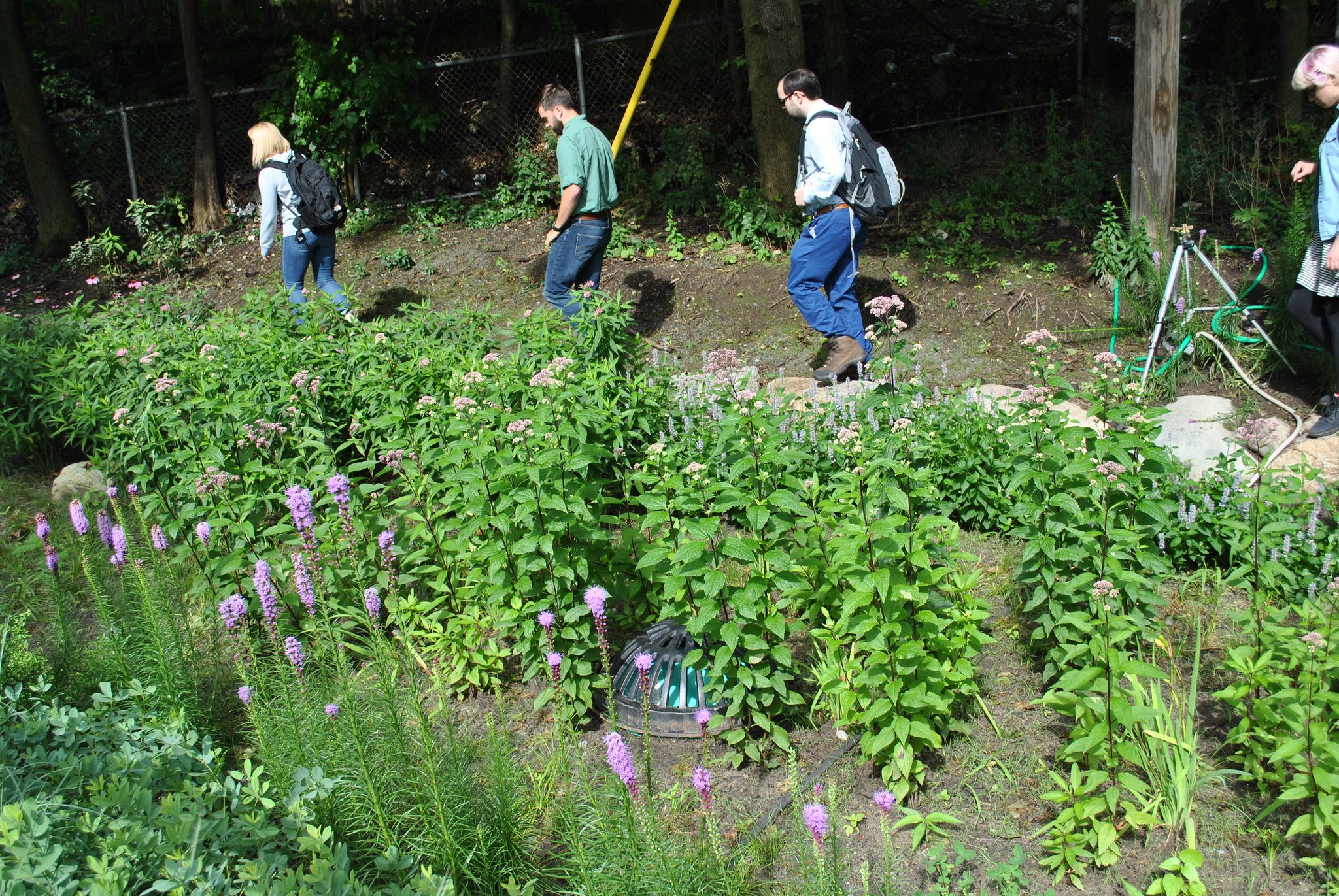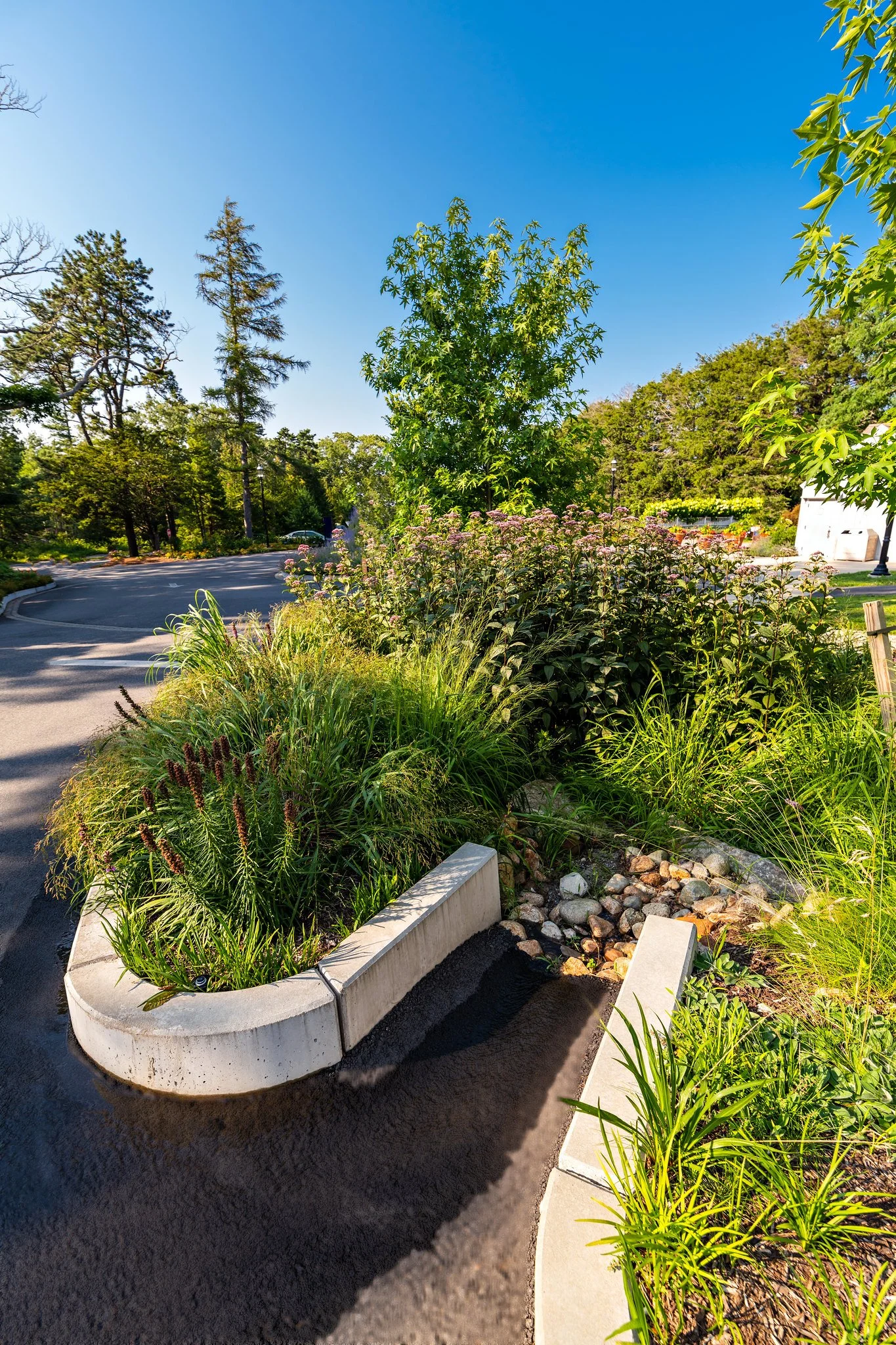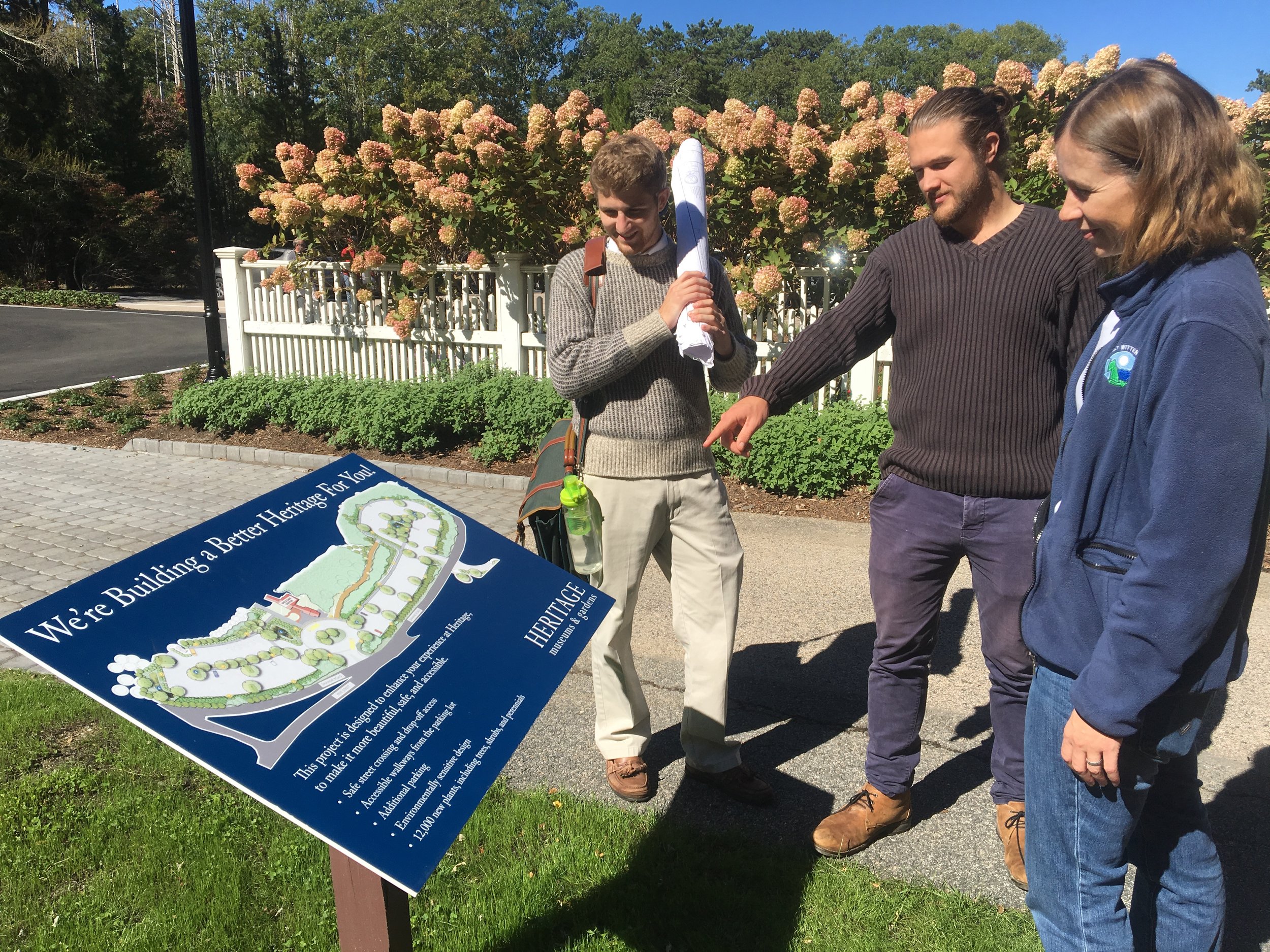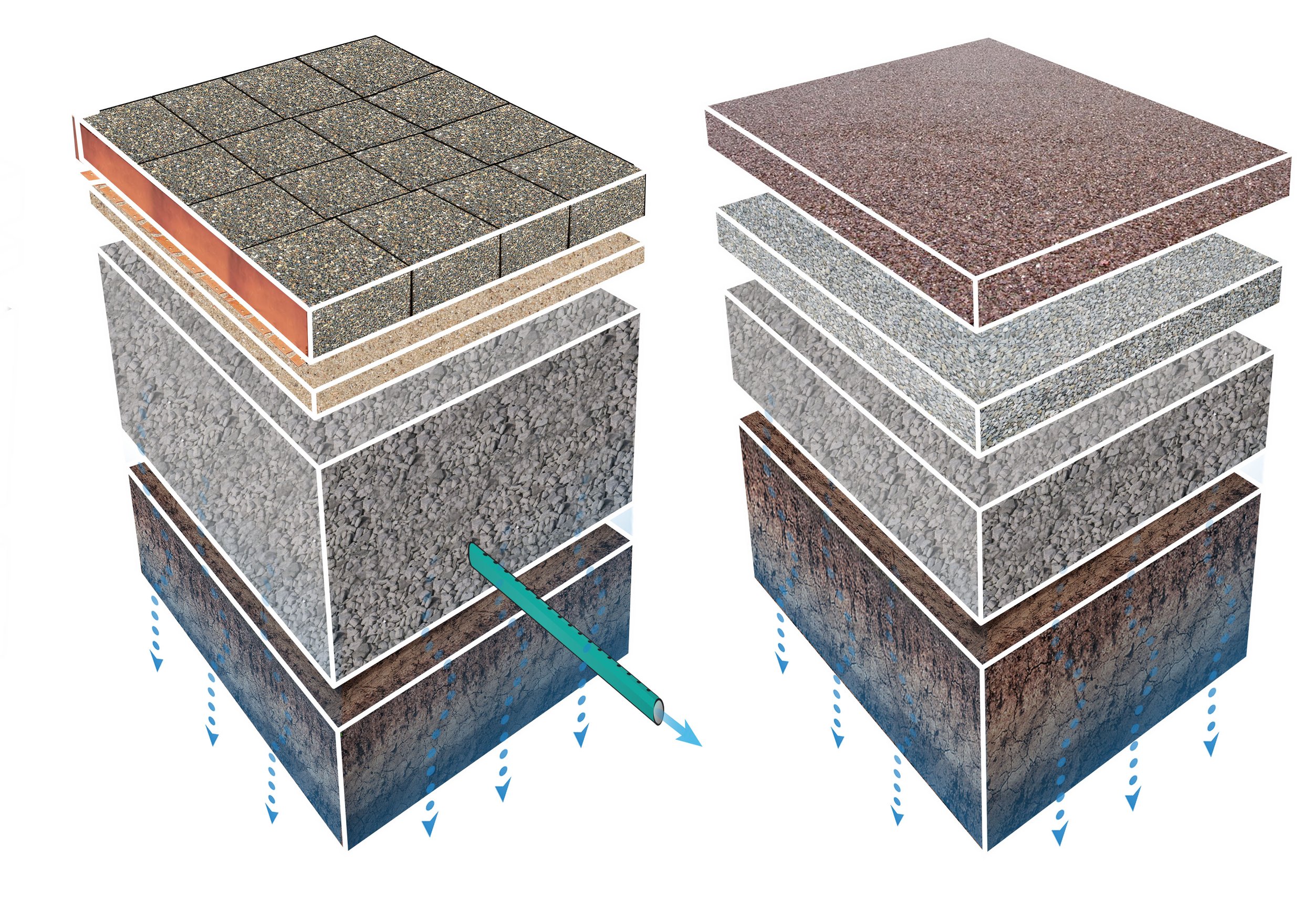
Green Stormwater Infrastructure on Campus
What is Green Stormwater Infrastructure?
Green stormwater infrastructure is an approach to water management that protects, restores, or mimics the natural water cycle. It incorporates both the natural environment and engineered systems to provide clean water, conserve ecosystem values and functions, and provide many benefits to people and wildlife.
-American Rivers
Check out the video below to learn more about these nature-based solutions.
Where is GSI located on the Campus?
One of the project’s goals was to integrate as many different GSI practices throughout the site. Can you find them all? Take the walking tour to help see all of the practices and learn about each practice. More information is also provided below.
We hope the first thing you will notice on Campus is how much more green space has been added. One of the easiest methods to reduce the amount of stormwater runoff is to reduce the impervious cover across a site.
To start the tour, make your way to the right of the front of Town Hall. There you will find the first stop and a sign board waiting for you.
CAMPUS MAP
Types of GSI on Campus
In order to showcase how easy it can be to integrate innovative stormwater management controls on a site, the project designed six different GSI practices on the campus. Read more about each type of GSI below.
-
Pavement Reduction

-
Permeable Pavement

-
Permeable Pavers

-
Bioretention

-
Rain garden
-
Stormwater Planter

Pavement Reduction
Stormwater runoff is generated when precipitation from rain and snowmelt events flow over impervious surfaces and is unable to percolate into the ground. As it flows over these surfaces, which include paved streets, parking lots, walkways and rooftops, the quantity amasses at a quick pace and it accumulates debris, chemicals, sediment, or other pollutants that could adversely affect water quality. This poses many challenges to developed areas including flooded streets, strain on drainage conveyance systems, and waterbody and groundwater pollution.
One of the simplest green infrastructure techniques to deal with this is to reduce the amount of impervious surfaces and replace them with areas that can absorb and hold water where if falls. This is achieved through pervious pavements which are located throughout the campus, however the simplest solution is to include more greenspace! In Mendon, this is especially important, since the majority of the town relies on private well water.
Permeable Pavement
On a typical paved surface, stormwater hits the hard material and quickly runs off into a drainage system or an adjacent green space. When this happens water accumulates quickly creating excess stormwater runofff and carries with it pollutants from the surfaces it encounters. One way to handle the excess stormwater is to capture it where it falls with pervious pavement.
Pervious Pavement is a hard surface that has enough gaps in it to allow water to run through it where it can be stored in gravel and/or infiltrated into the ground. When infiltrating isn’t an option, an underdrain can be used to transport excess water to other infiltrating or storage practices. On the Campus, pervious pavement, in the form of pervious asphalt and pavers, can be found in several locations with and without an underdrain. The pervious asphalt is achieved, in part, by using less fine aggregate content in the mix which creates open space for water to pass through.
Permeable Pavers
Similar to pervious pavement, these paver systems are constructed to allow stormwater runoff to infiltrate around the grid of pavers. These paver systems are strong enough to withstand vehicular movement and loads. Pavers can be planted with grass, so when the grass grows in, you can barely notice the pavers. The pavers are being used next to the fire emergency water cistern, located at the back of the campus. These pavers allow the fire trucks and other emergency vehicles to access this part of the campus while adding a green area.
Bioretention
Bioretention facilities collect, slow, clean, and sometimes infiltrate the stormwater runoff. The bioretention practice behind Town Hall collects runoff through a trench drain in the sidewalk, to a paved flume (to prevent erosion during heavy storms) where it is slowed in a sediment forebay to let suspended particles drop out. Next, it overflows into the planted area where it physically filters through organic layers allowing pollutants to be removed and water to be infiltrated where it can recharge groundwater. If the planted area receives more water than it can hold and infiltrate, the excess overflows into an outlet structure and connects back to the piped drainage system. There is a similar bioretention facility behind the Annex building, except this facility discharges overland to the back of the site.
Plants are an important component to these types of systems. They work to maintain healthy soil /filter media, absorb excess pollutants, help mitigate heat island effect, and soak up excess water, releasing some of it through transpiration. On top of this, the conditions are typically difficult with excess salts when near parking lots and large swings between inundated and drought conditions. Selecting the correct plant material should take all of these constraints into consideration, along with typical planting factors such as sun exposure and depth of inundation during rainfall events.
Selecting Native Plants is another great way to layer additional benefits into the system. A plant is considered native if it has occurred naturally in a particular region or ecosystem without human introduction. Frequently, these plants are better adapted to local conditions and need less fertilizers, pesticides or use less water. Additionally they formed symbiotic relationships with native wildlife over thousands of years, and offer sustainable habitat.
Rain Garden
While both rain gardens and bioretention facilities utilize a combination of soil and plant material to treat stormwater events, bioretention facilities are held to a higher design standard and are specifically designed to meet project goals related to saturated hydraulic conductivity and pollutant removal. They are also often inferred to be larger-scaled systems with designed outlets to control system hydraulics and media that is engineered for stormwater holding/filtration capacity.
Given the simplicity of rain gardens, they make a perfect addition to residential or small business properties!
Stormwater Planter
For some locations, such as building roofs, reducing impervious isn’t possible. However capturing and using the runoff in landscape elements can be a good option. The Campus does this with a planter box that absorbs some of the runoff from Town Hall before releasing excess into the drainage system. The planter box installed in the small park next to Town Hall is custom made, however, there are many pre-made options that can fit different locations. This is a creative solution that can add flexibility to very tight areas where some of the larger green stormwater infrastructure techniques are not possible. On top of that, you can add some green to locations that might not have supported it otherwise! Take a peak inside the planter box. You will see plants here too that play an important role to maintain healthy soil /filter media, absorb excess pollutants, help mitigate heat island effect, and soak up excess water, releasing some of it through transpiration.
"This project will create a nice look for the Town Hall area while improving parking/access. The team did a great job working with public safety to make sure the design met requirements for safety."
— Bill Kessler, Mendon Fire Chief











